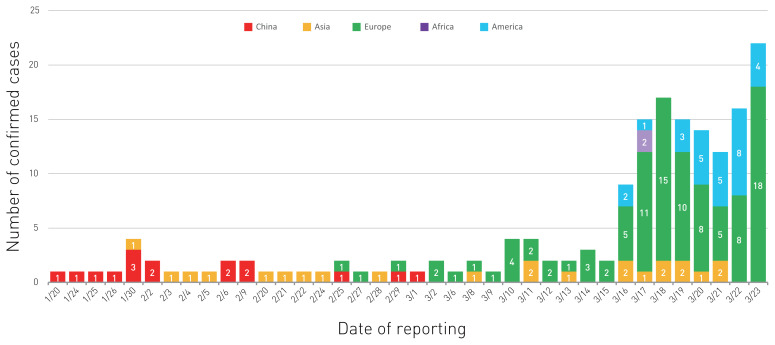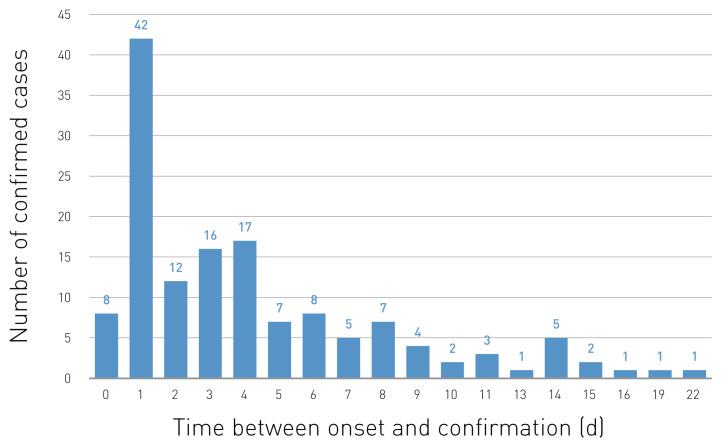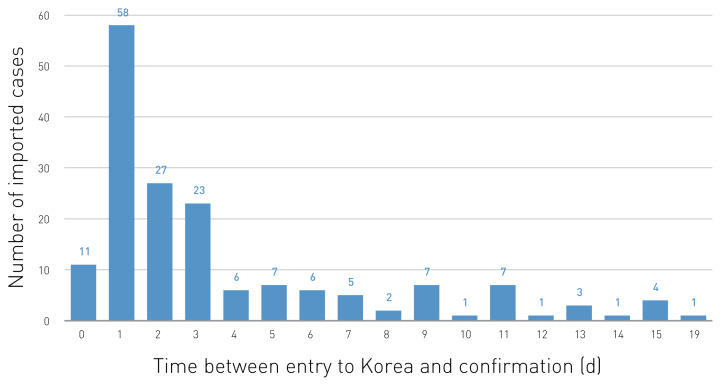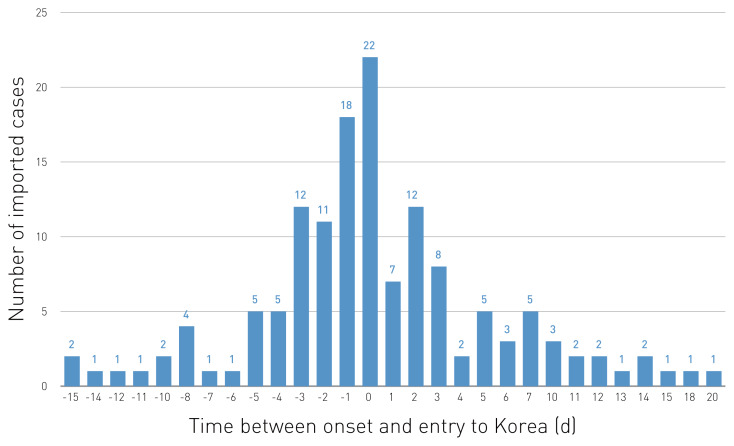Abstract
This study aimed to observe the initial trend of imported COVID-19 cases in South Korea since the beginning of the outbreak. All imported cases were classified into 5 regions (China, Asia, Europe, Africa, and America) according to travel history and potential exposure to the COVID-19. The list of countries for which confirmed cases had a travel history (single visit, multiple visits) and presented, were used to estimate the potential “exposure countries” of confirmed cases. For better understanding of the overall imported cases, time differences (day) among 3 major steps (symptom onset, entry to South Korea, laboratory confirmation) were measured based on available data. From the first importation of a COVID-19 case on January 20th, a total of 171 imported cases have been officially reported in South Korea as of March 23rd 2020. The overall trend of importation has significantly changed during this period. Importation of confirmed cases were initially from China, and subsequently from other Asian countries. After that, importation from Europe rapidly increased, with importation from America also increasing. One hundred fifteen (81%) were confirmed within 7 days of symptom onset. One Hundred forty three (84.1%) imported cases were confirmed within a week after entry into South Korea. One hundred seven imported cases (75.9%) developed symptoms within 5 days before or after, entry to South Korea. Streamlined processes of detection, subsequent testing, isolation, and treatment by public health authority, was key in minimizing the risk of secondary transmission.
Keywords: COVID-19, imported case, early trend
Introduction
Since the beginning of the COVID-19 outbreak in China, the Korea Centers for Disease Control and Prevention (KCDC) has been closely monitoring the importation of the virus to Korea to assess the risk of further spread into the community [1]. Point of entry control is one of the public health measures that has been strengthened in Korea, especially after the MERS-CoV outbreak in 2015. Based on point of entry, and follow up of suspected cases at the community level, KCDC identified imported cases of COVID-19. As this virus spread to other countries leading to the overall situation evolving into a global pandemic as declared by WHO, the overall trend of importation has been updated. This study describes the early trend of imported COVID-19 cases in South Korea from January 20th to March 23rd 2020, with descriptive analysis.
Materials and Methods
All incoming travelers are required to go through entry screening procedures and requested to monitor symptom development for 14 days after entry to South Korea. Once a traveler contact local public health center, initial epidemiologic investigation as well as laboratory test is conducted. The data source was based on preliminary epidemiological investigations of imported cases from January 20th to March 23rd 2020. Demographic factors, and travel history within 14 days before the entry to South Korea, were collected for descriptive analysis. To observe the initial trend of imported COVID-19 cases, all imported cases were classified into 5 regions (China, Asia (excluding China), Europe, Africa, and America) according to travel history, and potential exposure to COVID-19.
The list of countries for which confirmed cases had visited were classified into 2 categories (single visit, and multiple visits), and presented to estimate the potential exposure countries of confirmed cases. For better understanding of the overall imported cases, time differences (days) among 3 major steps (symptom onset date, entry date to South Korea, laboratory confirmation date) were measured based on the available data.
Results
From the first importation of a COVID-19 case on January 20th, a total of 171 imported cases have been officially reported in Korea as of March 23rd. Out of 171 total imported cases, 96 (56.1%) were male, and 75 (43.9%) were female. Reporting locations of imported cases, Incheon airport quarantine station reported the most cases (38.6%), followed by Seoul (26.9%) and Gyeonggi (18.7%). Daegu only reported 2 imported cases despite there being a major cluster of infections in the city (Table 1). Gimhae airport quarantine station reported 1 imported case. The main age groups of imported cases were people in their 20s (43.9% of total cases) and 30’s [24.0% of total cases (Table 2)].
Table 1.
Reporting location of imported COVID-19 in South Korea.
| Reporting location | n | % |
|---|---|---|
| Incheon airport quarantine station | 66 | 38.6 |
| Seoul | 46 | 26.9 |
| Gyeonggi | 32 | 18.7 |
| Ulsan | 5 | 2.9 |
| Incheon | 5 | 2.9 |
| Gwangju | 4 | 2.3 |
| Cheonbuk | 3 | 1.8 |
| Chungnam | 3 | 1.8 |
| Kyoungnam | 2 | 1.2 |
| Daegue | 2 | 1.2 |
| Gimhae airport quarantine station | 1 | 0.6 |
| Kangwon | 1 | 0.6 |
| Busan | 1 | 0.6 |
| Total | 171 | 100.0 |
Table 2.
Age group of imported COVID-19 in South Korea.
| Age group (y) | n | % |
|---|---|---|
| 0–9 | 1 | 0.6 |
| 10–19 | 9 | 5.3 |
| 20–29 | 75 | 43.9 |
| 30–39 | 41 | 24.0 |
| 40–49 | 20 | 11.7 |
| 50–59 | 13 | 7.6 |
| 60–69 | 10 | 5.8 |
| 70–79 | 2 | 1.2 |
| Total | 171 | 100.0 |
The overall trend of importation has significantly changed during the study period (Figure 1). As this virus originated from China, imported cases including the first imported case, were mainly from China until the beginning of February. The importation of cases from other Asian countries has been relatively consistent over the study period (maximum 1–2 cases per day) since the first imported case on January 30th. The first imported case from a European country was reported on February 25th, and the number of imported cases from Europe has rapidly grown (especially after March 15th), where it reached 18 cases per day on March 23rd. Importation from America was observed on March 16th, and the number of cases has been consistent with 1–8 cases per day. There have been 2 confirmed cases imported from Africa which were reported on March 17th, and no additional importation has been reported to date (March 23rd).
Figure 1.
Early trend of imported COVID-19 cases in South Korea.
Among 142 imported cases whose symptom onset date was available, a time difference between symptom onset and laboratory confirmation ranged from 0 to 22 days (Figure 2). There were 115 (81%) imported cases that were confirmed positive within 7 days after symptom onset, and 42 cases (29.6%) were confirmed just 1 day after symptom onset. Only 5 cases (3.5%) were confirmed after 14 days of symptom onset.
Figure 2.
Time difference between symptom onset and confirmation of COVID-19 in imported cases into South Korea.
One hundred seventy imported cases had clear information on their entry date to South Korea. The time difference between entry and confirmation is presented in Figure 3. More than half of imported cases (56.5%) were confirmed within 2 days after entry. One hundred forty three (84.1%) of imported cases were confirmed within a week after entry to South Korea. There were 5 cases (2.9%) confirmed 14 days after entry.
Figure 3.
Time difference between entry and confirmation of COVID-19 in imported cases into South Korea.
The time difference between symptom onset and entry date among 141 imported cases are presented in Figure 4. There were 64 imported cases (45.4%) that entered South Korea before symptom onset, while 55 cases (39%) developed symptoms after entry into Korea. There were 22 cases (15.6%) that developed symptoms on the day that they entered South Korea. Based on this information, 107 imported cases (75.9%) developed symptoms within 5 days before or after, entry to South Korea.
Figure 4.
Time difference between symptom onset and entry of COVID-19 imported cases into South Korea.
There were 123 (71.9%) out of 171 imported cases that had a history of visiting 1 country. The number of confirmed cases from a visit to a single country is as follows; US 23, China 16, UK 14, Spain 11, France 10, Philippines 10, Italy 9, Thailand 5, Germany 4, Ireland 4, Hungary 3, Switzerland 2, Singapore 2, Egypt 2, Japan 2, Canada 2, Netherland 1, Vietnam 1, Iran 1, Czech Republic 1. There were 48 imported cases that had visited more than 1 country, and the number of countries visited included; France 22, UK 17, Spain 12, Germany 11, Netherland 7, Czech Republic 6, Austria 5, Italy 5, Switzerland 4, US 3, Morocco 3, Hungary 3, Europe (not specified) 3, Hong Kong 2, Colombia 2, Malaysia 2, Ireland 1, Turkey 1, Cambodia 1, Philippines 1, Portugal 1, Singapore 1, Thailand 1, Taiwan 1, Poland 1, and Belgium 1.
Discussion
Importation of a pathogen and its associated secondary transmission is a major pattern of the outbreak of a novel pathogen, where the pathogen did not originate within the country. Initially, importation from China into South Korea of the first case of COVID-19 and its associated secondary infections among contacts, have been part of the major pattern of transmission [2]. However, this trend changed as COVID-19 spread to other Asian countries. Confirmed imported cases have been reported 10 days after the identification of the first imported case. COVID-19 was first confirmed in Japan on January 16th, it took 3 serial intervals for the virus to be imported from Japan to Korea [3]. This proved to be a rapid spread of the virus between countries, leading to the COVID-19 pandemic. Importation of cases from Asia to South Korea have been relatively consistent over the study period. European countries became the main source of importation and this trend continued until March 23rd. Importation from America (mainly from US) was reported on March 16th and continued until March 23rd. There were 2 imported cases from Egypt. This overall trend can potentially show the development of the situation and the international spread of COVID-19. It first started in China and spread to other Asian countries, Europe and Africa, and eventually spreading to America [4]. The rapidly changing dynamics of imported cases are indirect evidence of geographic spread of COVID-19.
Gender distribution of imported cases was different from overall confirmed cases in South Korea in which more female confirmed cases have been reported. Geographical distribution of imported cases have very different figures compared with the overall number of confirmed cases in South Korea. Whilst major clusters of cases in South Korea were reported in Daegu, imported cases were mainly reported from populated areas, including Seoul and Gyeonggi [5]. Geographical location reporting of imported cases showed that the Incheon airport quarantine station, were highly effective in determining where infected individuals traveled from, including 1 imported case which was identified by Gimhae airport quarantine station. A large proportion of imported cases (39.2%) were identified by the quarantine station. It clearly indicates that quarantine stations have big roles in terms of screening and isolation of infected travelers before they come into contact with the general public. This point of entry preparedness and laboratory testing capacity were the main outcome of the investment that the Korean government made over a long period of time.
All imported cases were confirmed within a month of symptom onset, and it is noteworthy that the majority of cases received laboratory confirmation of COVID-19 within 7 days after symptom onset. There were 29.6% of imported cases that were confirmed just 1 day after entry to South Korea. This shows that providing the necessary information, and having guidelines at the point of entry into the country was critical for rapid detection of potential cases through monitoring of the development of clinical symptoms in travelers. Streamlined processes of detection, subsequent testing, isolation, and treatment by public health authority, was key in minimizing the risk of secondary transmission. Likewise, more than half of the imported cases were confirmed within 2 days after entry to the country, and this is due to the measures implemented by quarantine stations.
There were no major differences between the number of cases that developed before entry (45.4%), and the number of cases that developed after entry (39.0%) during the study period. When cases (15.6%) that had developed symptoms on the entry date were included, 61% of imported cases had already recognized their clinical symptoms before entering the country, and it indicated that implementing comprehensive contact tracing of previously exposed environments, including the flight, arrival gate and relevant locations in the airport were crucial in tracing potential contacts of COVID-19. There were 75.9% of confirmed cases who developed symptoms within 5 days before or after entry into Korea, and this statistic highlighted the need for follow up and monitoring of travelers, especially those who had a history of travelling from COVID-19 affected countries. Without having appropriate monitoring and follow up measures, secondary transmission through infected travelers was inevitable and could potentially have led to widespread transmission in South Korea.
Based on imported cases who traveled to just 1 country, importation of COVID-19 was reported most frequently by people traveling to South Korea from the US (n = 23). Travel from China to South Korea was the next most frequent (n = 16). Travel from Europe accounted for a high number of imported cases (UK 14, Spain 11, France 10, Germany 4, Ireland 4, Hungary 3, Switzerland 2, and Netherland 1). Among Asian countries (except for China), travel from the Philippines accounted for 10 cases. There were 5 cases of travel from Thailand, and 2 cases of travel both Japan and Singapore. and 1 case from Vietnam. The majority of confirmed cases of COVID-19 in people who visited more than 1 country, had travelled between European countries before travelling to Korea. This maybe due to geographic vicinity of European countries. Specific countries could not be specified in those imported cases with multiple visits, just the number of visited countries were reported, and this number does not necessarily represent the extent of importation of COVID-19 from those countries.
There were some limitations in this study. Even though KCDC disclosed all imported COVID-19 cases, asymptomatic cases could have been missed, especially during the initial stage of outbreak in China. This indicates that all reported cases may not fully represent the entire imported COVID-19 cases in South Korea, though the missing number of cases is likely to be small given the relatively low number of sporadic cases in South Korea. Overall entry screening procedures have been changed since the beginning of the outbreak in China and it might have affected the trend of imported cases during the study period. Data for some imported cases of travelers who had traveled to more than 1 country before traveling to South Korea, did not allow for a country to be specified. Symptom onset date of confirmed cases were based on preliminary epidemiological investigations and can be updated after further investigations. Lastly, this study period only covered the initial stage of the COVID-19 pandemic and the overall pattern of import from various countries will change by the end of the pandemic. Although there are limitations in this study, this descriptive analysis of the early trend of imported cases into South Korea can clearly provide an understanding of the situation for importation pattern to date, and highlight the importance of monitoring and follow up of incoming travelers from COVID-19-affected countries. This data can be used for planning and implementation of point of entry control measures. For this reason, monitoring and simple descriptive analysis needs to be continued for as long as COVID-19 continues to spread through other countries.
Acknowledgments
We acknowledge the effort and hard work of all the staff in the Korea Centers for Disease Control and Prevention, and provincial governments in responding to COVID-19. The following people/teams contributed to this article.
-
Situation Analysis and International Cooperation Team
Inho Kim, Jia Lee, Seon Kui Lee
-
Information Analysis Team
Miyoung Kim, Sanghui Kweon
Quarantine Management Team
-
Incheon Airport National Quarantine Station
Ja Eun Kim, Ji Hye Moon
Footnotes
Conflicts of Interest
There are no conflicts of interest to declare.
References
- 1.Kim I, Lee J, Lee J, et al. KCDC Risk Assessments on the Initial Phase of the COVID-19 Outbreak in Korea. Osong Public Health Res Perspect. 2020;11(2):67–73. doi: 10.24171/j.phrp.2020.11.2.02. [DOI] [PMC free article] [PubMed] [Google Scholar]
- 2.Korea Centers for Disease Control and Prevention [Internet] Press Release: The first imported case of the novel coronavirus (2019-nCoV) in Korea. [cited 2020 Mar 30]. Available from: https://www.cdc.go.kr/board/board.es?mid=a30402000000&bid=0030.
- 3.Nishiura H, Linton NM, Akhmetzhanov AR. Serial interval of novel coronavirus (COVID-19) infections. Int J Infect Dis. 2020;93:284–6. doi: 10.1016/j.ijid.2020.02.060. [DOI] [PMC free article] [PubMed] [Google Scholar]
- 4.World Health Organization [Internet] Coronavirus disease 2019 (COVID-19) Situation Report-63. [cited 2020 Mar 30]. Available from: https://www.who.int/docs/default-source/coronaviruse/situation-reports/20200323-sitrep-63-covid-19.pdf?sfvrsn=b617302d_4.
- 5.Korea Centers for Disease Control and Prevention [Internet] Press Release: The updates on COVID-19 in Korea as of 24 March. [cited 2020 Mar 30]. Available from: https://www.cdc.go.kr/board/board.es?mid=a30402000000&bid=0030.






